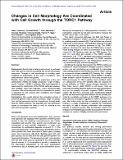| dc.contributor.author | Goranov, Alexi I. | |
| dc.contributor.author | Gulati, Amneet | |
| dc.contributor.author | Dephoure, Noah | |
| dc.contributor.author | Takahara, Terunao | |
| dc.contributor.author | Maeda, Tatsuya | |
| dc.contributor.author | Gygi, Steven P. | |
| dc.contributor.author | Manalis, Scott R | |
| dc.contributor.author | Amon, Angelika B | |
| dc.date.accessioned | 2015-03-27T16:34:22Z | |
| dc.date.available | 2015-03-27T16:34:22Z | |
| dc.date.issued | 2013-06 | |
| dc.date.submitted | 2013-04 | |
| dc.identifier.issn | 09609822 | |
| dc.identifier.issn | 1879-0445 | |
| dc.identifier.uri | http://hdl.handle.net/1721.1/96218 | |
| dc.description.abstract | Background:
Growth rate is determined not only by extracellular cues such as nutrient availability but also by intracellular processes. Changes in cell morphology in budding yeast, mediated by polarization of the actin cytoskeleton, have been shown to reduce cell growth.
Results:
Here we demonstrate that polarization of the actin cytoskeleton inhibits the highly conserved Target of Rapamycin Complex 1 (TORC1) pathway. This downregulation is suppressed by inactivation of the TORC1 pathway regulatory Iml1 complex, which also regulates TORC1 during nitrogen starvation. We further demonstrate that attenuation of growth is important for cell recovery after conditions of prolonged polarized growth.
Conclusions:
Our results indicate that extended periods of polarized growth inhibit protein synthesis, mass accumulation, and the increase in cell size at least in part through inhibiting the TORC1 pathway. We speculate that this mechanism serves to coordinate the ability of cells to increase in size with their biosynthetic capacity. | en_US |
| dc.description.sponsorship | American Cancer Society (Postdoctoral Fellowship) | en_US |
| dc.description.sponsorship | National Cancer Institute (U.S.). Physical Sciences Oncology Center (Contract U54CA143874) | en_US |
| dc.language.iso | en_US | |
| dc.publisher | Elsevier | en_US |
| dc.relation.isversionof | http://dx.doi.org/10.1016/j.cub.2013.05.035 | en_US |
| dc.rights | Article is made available in accordance with the publisher's policy and may be subject to US copyright law. Please refer to the publisher's site for terms of use. | en_US |
| dc.source | Elsevier Open Archive | en_US |
| dc.title | Changes in Cell Morphology Are Coordinated with Cell Growth through the TORC1 Pathway | en_US |
| dc.type | Article | en_US |
| dc.identifier.citation | Goranov, Alexi I., Amneet Gulati, Noah Dephoure, Terunao Takahara, Tatsuya Maeda, Steven P. Gygi, Scott Manalis, and Angelika Amon. “Changes in Cell Morphology Are Coordinated with Cell Growth through the TORC1 Pathway.” Current Biology 23, no. 14 (July 2013): 1269–1279. © 2013 Elsevier Ltd. | en_US |
| dc.contributor.department | Massachusetts Institute of Technology. Department of Biological Engineering | en_US |
| dc.contributor.department | Koch Institute for Integrative Cancer Research at MIT | en_US |
| dc.contributor.mitauthor | Goranov, Alexi I. | en_US |
| dc.contributor.mitauthor | Gulati, Amneet | en_US |
| dc.contributor.mitauthor | Manalis, Scott R. | en_US |
| dc.contributor.mitauthor | Amon, Angelika B. | en_US |
| dc.relation.journal | Current Biology | en_US |
| dc.eprint.version | Final published version | en_US |
| dc.type.uri | http://purl.org/eprint/type/JournalArticle | en_US |
| eprint.status | http://purl.org/eprint/status/PeerReviewed | en_US |
| dspace.orderedauthors | Goranov, Alexi I.; Gulati, Amneet; Dephoure, Noah; Takahara, Terunao; Maeda, Tatsuya; Gygi, Steven P.; Manalis, Scott; Amon, Angelika | en_US |
| dc.identifier.orcid | https://orcid.org/0000-0001-5223-9433 | |
| dc.identifier.orcid | https://orcid.org/0000-0001-9837-0314 | |
| mit.license | PUBLISHER_POLICY | en_US |
| mit.metadata.status | Complete | |
